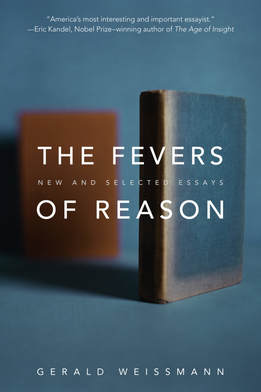As I approached The Fevers of Reason, I did so with a foot in each river of influence—or rather, a leg in one and a toe in the other. Weissmann’s essays discuss the intersection of various issues within medicine and popular culture. As a student of literature, I have often written extensive essays and participated in lengthy discussions of multiple works, like Arrowsmith and Sherlock Holmes,that Weissmann includes. Until recently, my knowledge of science and medicine has been rather superficial—me as a nervous patient in the waiting room. As my study of literature, guided by Elaine Scarry and Rita Charon, has begun to dip into the interaction between literature and medicine I’ve become more confident about the relationship between the two. Wearing my budding knowledge of the relatively young field like swimmies, I jumped right in to Weissmann’s collection and found a rich layering of past, present, science, and literature to present diverse takes on the issue at hand. He continuously draws connections between person and person, past and present, truth and fiction, and, most of all, literature and medicine. Weissmann links the two, starting from the prefatory note, by explaining both the scientific method and organization of essays—or lack thereof. Each essay begins with at least one epigraph, often providing a definition or thoughtful viewpoint. In “Going Viral,” the first chapter, Weissmann examines contemporary issues, like literal diseases or the metaphorical disease of gun violence, through the lens of past theory. The term “going viral” is contemporarily used to describe something of massive popularity, often on the internet. He traces the term to its disease origin before cycling back to use it to describe gun violence as a pandemic. In another essay, Weissmann uses French scientist Dr. Adrien Proust’s emphasis on quarantine to challenge the modern-day response to Ebola. Interestingly, Weissmann ties another thread into this web by including snippets of criticism by Marcel Proust, novelist son of Adrien. Weissmann mirrors this thematic connection on a minor level as well. He describes the crowd at a science lecture, emphasizing their heterogony: “I spotted working scientists, grad students, lab assistants, undergraduates, a score of academicians, a Nobel laureate or two, attentive families and friends, hailing from all corners of the globe. The dress code ranged from country jeans to khakis, bike gear to saris, backpacks to bow ties.” (17) This section reveals that Weissmann not only endeavors to connect the realms of literature and medicine, but also to create community among readers in light of class, race, religion, and age. He presents this diverse group, inviting us all to partake in his discussions of science and literature despite the ways we may have been excluded from either discipline in the past.
Weissmann continues community-building through the third chapter, “Two for the Road,” where he focuses on partnerships that produced major scientific and literary advances. Some of the cases unite medicine and literature, but each one emphasizes the theme of union and collaboration throughout the essays. One essay from Chapter 3 focuses on “American the Beautiful,” a poem by Katherine Lee Bates, which is often sung. You may have heard of it. The poem can also be utilized by people to enforce nationalism and even challenge the rights of others—like the right to marriage. Essentially, they take Bates’ words and use them to separate and destroy community. Weissmann skillfully comes full circle by discussing Bate’s long-time relationship with her partner Katherine Coman and confronting the use of a poem written by a lesbian to champion against gay rights. He argues for the strength of their union as a major contributor to the creation of the poem in the first place, making it inherently unifying. In “Beside the Golden Door,” Weissmann again employs his system of parallels to challenge hegemonic reasoning and draw attention to injustices that compromise community. This chapter focuses on science advances made by immigrants, like Albert Einstein and Eric Kandel. He explores not only their trememndous works, but also the lands they left to live in America. In many cases, these great minds were seeking freedom from persecution based on race and religion. Ever the master of irony, Weissmann ends the chapter with an essay on Percy Lavon Julian, a scientist who worked on the synthesis of cortisone, and the racial violence and disparagement he faced. By compiling these essays alongside one another, Weissmann mimics the amalgamation that occurs in the country as a whole, asserting that, while different, each story is valuable and must be read. Throughout The Fevers of Reason, I learned quite a bit about science, medicine, and even history. I was also rather surprised to find that I learned about literature, despite thinking I knew so much. With essays that incorporate summaries of both plots and research studies, Weissmann presents an abundance of knowledge to take away from The Fevers of Reason. Each reader can find a few things they recognize and more than a few they need to Google. However, there is also a well of wisdom from which to draw. For all of Weissmann’s comparisons and allusions, his guiding force proves continuously to be humanity itself and the messy ways we come together and break apart.
0 Comments
Leave a Reply. |
Archives
April 2024
Categories
All
|
|
Glassworks is a publication of Rowan University's Master of Arts in Writing 260 Victoria Street • Glassboro, New Jersey 08028 glassworksmagazine@rowan.edu |
All Content on this Site (c) 2024 Glassworks
|


 RSS Feed
RSS Feed
